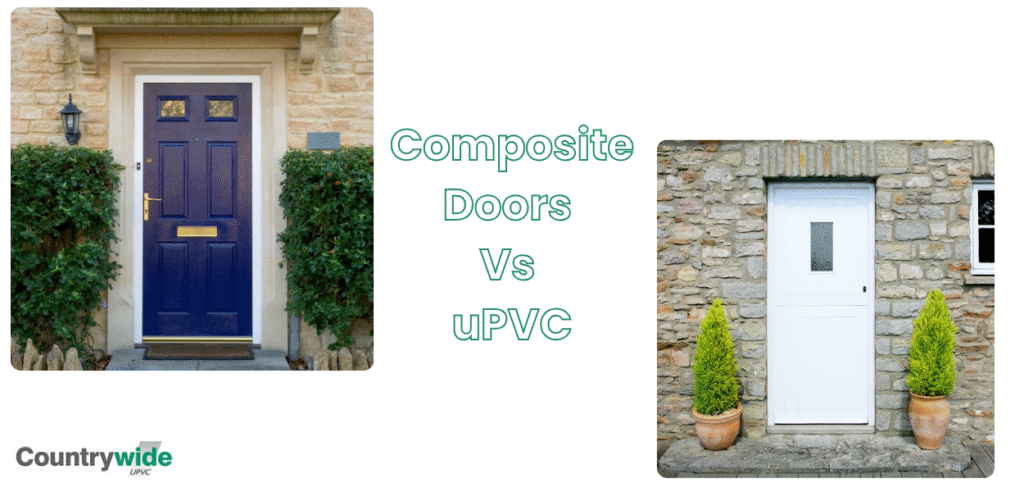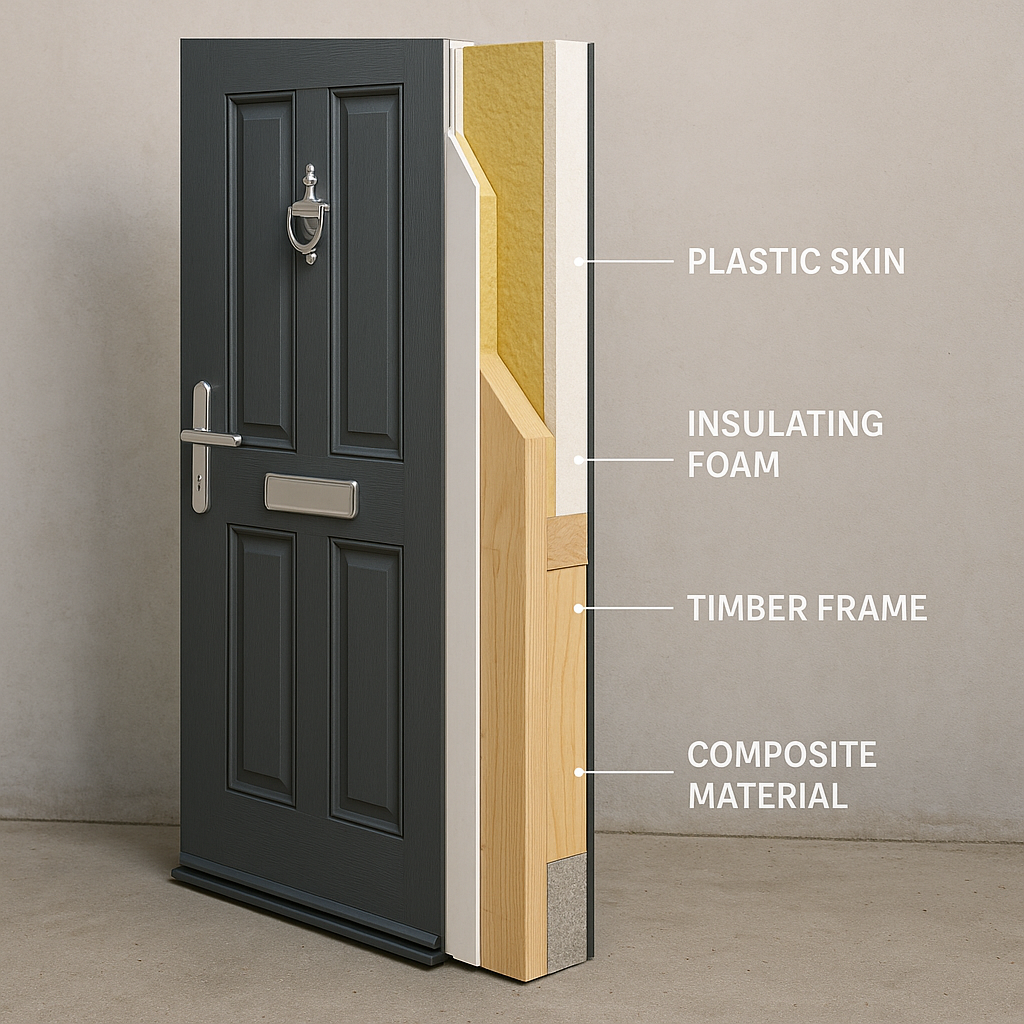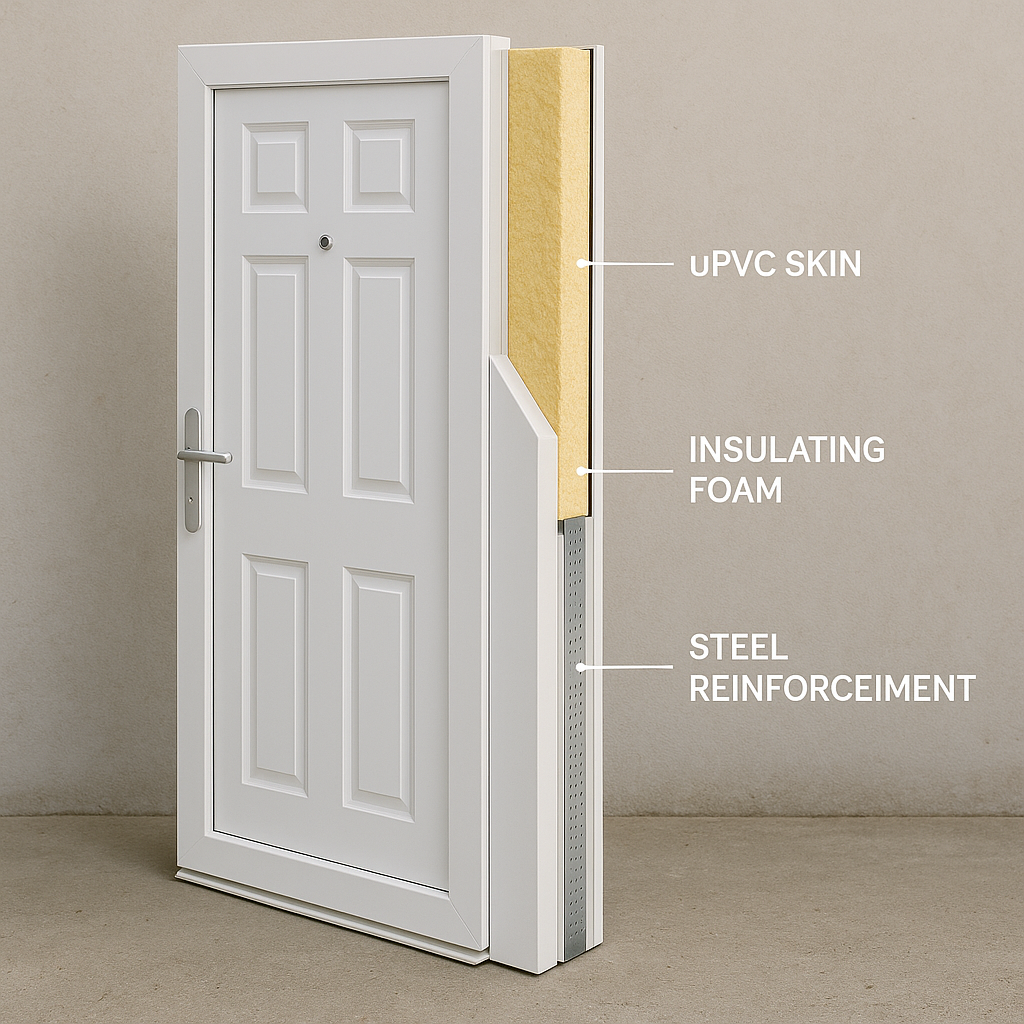Composite or uPVC door? When comparing the two, UPVC doors win on upfront affordability and simplicity, while composite doors deliver greater value through longevity, strength, and a premium look. For homeowners focused on long-term investment, composite doors provide unmatched durability, enhanced security, and improved thermal efficiency, making them a standout choice for both performance and style.
Composite doors are designed using a combination of advanced materials such as GRP, foam, and timber. This layered construction gives them a solid, robust structure that excels in strength, security, and insulation. With a thicker build and a woodgrain finish that replicates the look of real timber, composite doors not only improve energy efficiency but also elevate the overall aesthetic appeal of a home. Their superior resistance to weathering ensures they maintain their performance and appearance for decades.
UPVC doors, on the other hand, are made from a single material, offering a lightweight and cost-effective solution. They are known for being low maintenance, easy to clean, and durable enough to provide good insulation and security at an affordable price point. While they represent a practical choice for homeowners seeking budget-friendly options, they lack the structural depth and long-term resilience of composite doors.

| Comparison Criteria | Composite Doors | uPVC Doors |
|---|---|---|
| KEY SPECIFICATIONS | ||
| Initial Cost | £550 – £2,500 (supply only) £850 – £3,000 (installed) |
£300 – £900 (supply only) £459 – £1,200 (installed) |
| Lifespan | 30-35+ years | 20-25 years |
| Door Thickness | 44-48mm | 28mm |
| Material Construction | Multi-layer: GRP outer skins, timber/foam core, steel reinforcement | Unplasticised PVC with steel reinforcement |
| U-Value (Energy Efficiency) | As low as 1.4 W/m²K (many models tested to FENSA standards; Energy Saving Trust notes improved insulation can reduce heating bills) |
Typically higher U-values (less efficient overall) |
| Security Level | High — multi-material build; often tested to PAS 24 standards and available with Secured by Design accreditation | Good — multi-point locking; PAS 24 compliance available on some models |
| Design Options | Extensive — leading manufacturers such as Solidor and Endurance offer wide RAL colour palettes and timber-look finishes |
Limited — fewer style options and a more plastic-like appearance |
| ADVANTAGES & DISADVANTAGES | ||
| PROS |
|
|
| CONS |
|
|
| IDEAL APPLICATIONS | ||
| Best For |
|
|

Composite doors represent sophisticated engineering, combining multiple materials to create a superior product. The core construction typically features a 44-48mm thick solid timber frame or high-density polyurethane foam core, providing exceptional structural integrity. This core is surrounded by Glass Reinforced Plastic (GRP) outer skins that are 2.5-4mm thick, offering weather resistance and aesthetic appeal.
The multi-layered approach includes reinforced steel cores in premium models, with some manufacturers incorporating 17 layers of engineered timber for maximum strength. CFC-free polyurethane foam fills any gaps, ensuring superior thermal performance while maintaining structural stability. Aluminium inserts are strategically placed to prevent warping and bowing, addressing common issues found in single-material doors.

uPVC doors utilize a simpler construction methodology, built around unplasticised polyvinyl chloride frames with galvanised steel reinforcement. The material composition involves rigid plastic that contains no plasticisers, making it more durable than standard PVC while maintaining weather resistance. Multi-chamber profiles within uPVC doors provide insulation, though typically achieving higher U-values compared to composite alternatives.
Modern uPVC doors often feature steel-reinforced frames to improve strength and security, though the overall thickness remains significantly less than composite doors at approximately 28mm compared to composite doors’ 44-48mm. The insulated frame sealed in plastic provides adequate thermal performance for budget-conscious applications.
Cross-section of a reinforced door panel showing durable skins, insulated polystyrene inner, and MDF core for strength and insulation.
Composite doors deliver superior security performance through their multi-material construction and advanced locking systems. The solid timber core construction makes them sledgehammer-proof, with some manufacturers achieving 48mm thickness that’s 50% thicker than most uPVC doors. Multiple materials working together create exceptional resistance to forced entry, with the combination of timber, GRP, and steel reinforcement providing layers of protection.
Advanced multi-point locking systems are standard on composite doors, typically featuring four self-locking deadbolt latches that engage at multiple points along the frame. Anti-snap cylinders with anti-pick and anti-drill protection are commonly included, providing state-of-the-art security technology. The structural integrity remains intact even under extreme force, ensuring the door frame and locking mechanisms work together effectively.
While uPVC doors offer good security through multi-point locking systems, they cannot match the physical strength of composite alternatives. Modern uPVC doors typically feature 3-5 point locking mechanisms, engaging hooks and bolts at multiple locations along the frame. Steel reinforcement within the frame improves resistance to forced entry, though the overall construction remains more vulnerable than composite doors.
The lightweight nature of uPVC makes it more susceptible to impact damage, with older models particularly vulnerable to panel kick-through. Enhanced security options are available as upgrades, including anti-snap cylinders and reinforced frames, though these additions increase the overall cost.
Composite doors excel in thermal efficiency through their sophisticated insulation design. High-density polyurethane foam cores provide exceptional heat retention, with many models achieving U-values as low as 1.4 W/m²K, exceeding current building regulations. The multi-layered construction creates superior insulation compared to single-material alternatives, with some composite doors offering thermal performance up to nine times better than timber.
Advanced sealing systems including brush seals and weather-proof gaskets eliminate draughts and heat loss. The thickness and density of composite construction naturally provides better thermal barriers, potentially saving £90-£100 annually on energy bills through improved heat retention. Triple glazing options are readily available for maximum thermal performance.
uPVC doors provide good insulation properties through their multi-chamber profiles and double glazing, though typically achieving higher U-values than composite alternatives. The plastic material offers decent thermal barriers, particularly when properly fitted with quality seals. Modern uPVC doors meet building regulations for energy efficiency, though they may not deliver the same long-term energy savings as composite doors.
Seal degradation over time can impact thermal performance, potentially allowing draughts as the door ages. The lighter construction means less thermal mass, requiring more sophisticated sealing systems to maintain energy efficiency throughout the door’s lifespan.
Comprehensive comparison between composite doors and uPVC doors across key performance criteria
Composite doors are engineered for exceptional longevity, with typical lifespans of 30-35 years with minimal maintenance. The multi-material construction resists common failure modes, including warping, cracking, fading, and weather damage. GRP outer skins are completely immune to sun fade and bleaching, maintaining their appearance throughout their service life.
Maintenance requirements are minimal, typically involving only occasional cleaning with soapy water and a soft cloth. The materials resist everyday knocks and scratches, while remaining colour-stable throughout their lifespan. No painting, varnishing, or regular treatment is required, making them ideal for busy homeowners.
uPVC doors offer solid durability with lifespans of 20-25 years, though this varies significantly with quality and maintenance. The material is impervious to water and won’t warp or swell, making it suitable for British weather conditions. Resistance to rot and moisture damage makes uPVC doors reliable for long-term use.
Some limitations affect long-term performance, including potential discoloration over time, particularly with white doors that may develop a yellowish tint. Exposure to extreme heat can affect uPVC frames, potentially causing expansion or contraction issues. Maintenance remains low but may increase as the door ages, with seal replacement occasionally required.
Composite doors offer extensive customisation options with over 1600 colour choices available from leading manufacturers. Realistic timber-grain finishes provide authentic wood appearance without maintenance requirements. Wide range of glazing options includes decorative glass panels, sidelights, and modern geometric designs.
Style versatility encompasses traditional and contemporary designs, allowing homeowners to match any architectural style. Premium hardware options including various handles, knockers, and letterboxes enable complete customisation. The authentic appearance closely mimics traditional timber doors, providing heritage aesthetics with modern performance.
uPVC doors provide good style variety though fewer options compared to composite alternatives. Colour choices include woodgrain finishes such as mahogany, along with popular colours including Chartwell Green, Agate Grey, and traditional white. Decorative glass panels can add individuality to otherwise similar-looking doors.
The inherent plastic appearance remains visible despite various finishes, creating a distinctive sheen that differs from natural materials. Customisation options include different panel configurations and hardware choices, though the range is typically more limited than composite offerings.
Composite doors represent a higher initial investment, with prices ranging from £550-£2,500 for supply only, and £850-£3,000 including installation. Premium installed composite doors from major manufacturers can start at £2,500 with full installation and guarantees. The higher cost reflects superior materials and construction methods that deliver enhanced performance.
uPVC doors offer budget-friendly pricing, starting from £300-£500 for supply only and reaching £900 including installation. Made-to-measure uPVC doors can start as low as £459 including VAT and delivery. The lower cost makes uPVC accessible for budget-conscious renovations though with performance compromises.
Composite doors provide superior long-term value through their 30-35 year lifespan versus uPVC’s 20-25 years. Energy savings of £90-£100 annually help offset the higher initial investment over time. Minimal maintenance costs and no requirement for painting or refinishing contribute to lifecycle value.
uPVC doors offer immediate affordability but may require more frequent replacement. The shorter lifespan means higher lifetime costs per year when calculated over extended periods. Potential seal replacement and maintenance costs can accumulate as the door ages.
Both door types perform well in UK weather conditions, though with different characteristics. Composite doors maintain structural integrity regardless of temperature extremes, humidity, or precipitation. GRP outer skins resist UV damage and maintain colour stability through seasonal changes. The multi-layer construction prevents warping and dimensional changes that affect door operation.
uPVC doors handle British weather effectively, showing resistance to moisture, wind, and temperature variations. The plastic material won’t rot or corrode, making it suitable for coastal areas with salt air exposure. However, extreme heat can cause expansion, potentially affecting door fit and operation.
Composite doors may experience occasional creaking during significant temperature changes as materials expand and contract. This is typically harmless and doesn’t affect performance, though it may be noticeable during extreme weather transitions. Professional installation minimises these issues through proper fitting techniques.
uPVC doors can face challenges with thermal expansion particularly in extreme heat, which may make closing difficult temporarily. Colour fading is possible over extended periods particularly with certain colours and orientations. Quality varies significantly with cheaper options more susceptible to weather-related degradation.
Both composite and uPVC doors benefit from professional installation to ensure optimal performance, security, and warranty coverage. Composite doors require skilled installation due to their heavier weight and precision requirements. Proper fitting is crucial for thermal performance, security effectiveness, and preventing operational issues.
uPVC door installation is typically more straightforward due to lighter weight and simpler construction. However, proper sealing and adjustment remain critical for energy efficiency and security performance. Both door types require precise frame preparation and alignment for optimal operation.
Composite doors are more expensive, heavier, and not easily modified once manufactured.
Yes, composite doors are worth the extra money because they offer superior security, durability, insulation, and aesthetics.
No, composite doors do not swell in the heat as they are engineered to resist warping and expansion.
uPVC doors are less robust, have a shorter lifespan, can discolour or warp over time, and look less premium than composites.
A composite door is better overall due to its strength, security, insulation, and lifespan.
A composite door typically lasts around 30 years or more.
Composite doors are usually £250–£1,000 more expensive than comparable uPVC doors.
No, composite doors are highly resistant to scratches thanks to their tough GRP skin.
It is extremely difficult to kick in a composite door due to its reinforced core and solid construction.
Related Posts:

Countrywide Upvc (NW) Ltd | Double Glazing | UPVC Windows & Doors
104 New Ct Way,
Ormskirk
L39 2YT
01695 579764
info@countrywideupvc.co.uk
Opening Hours
Monday to Friday: 9 am – 5 pm
Saturday & Sunday : Closed

